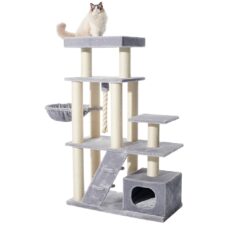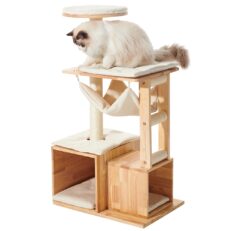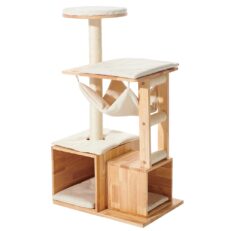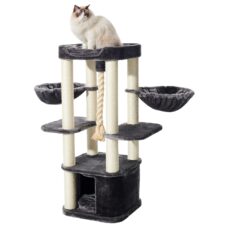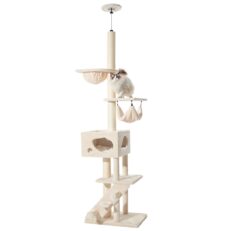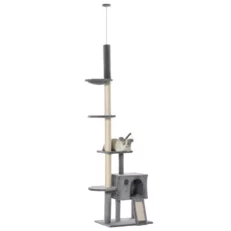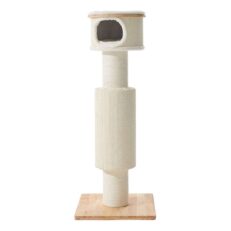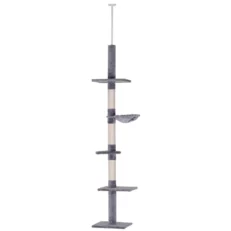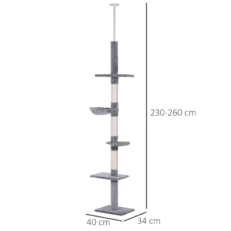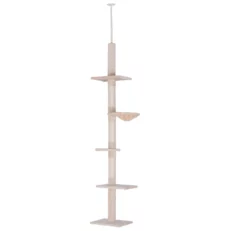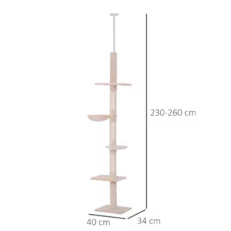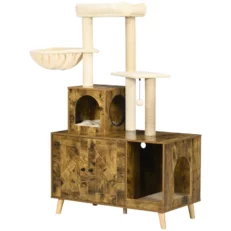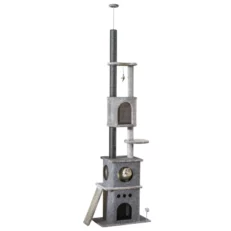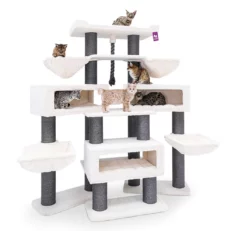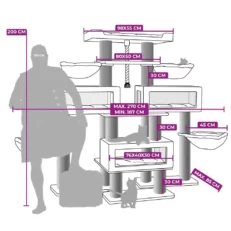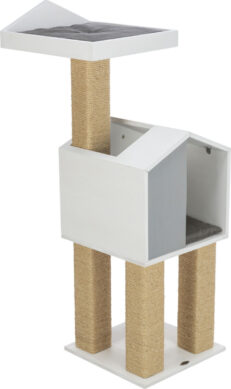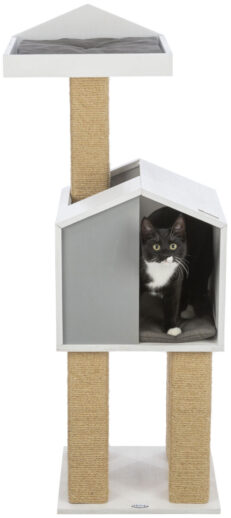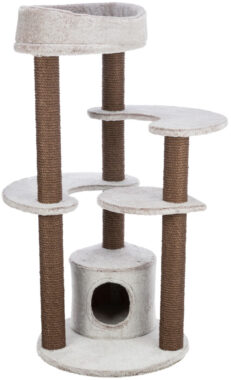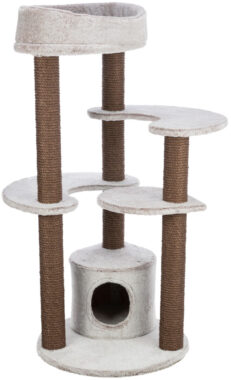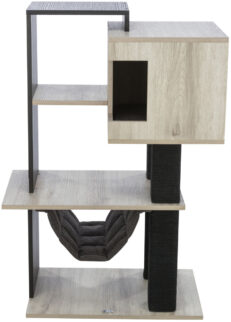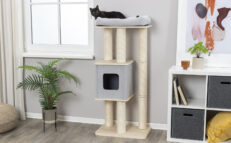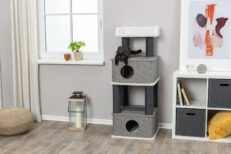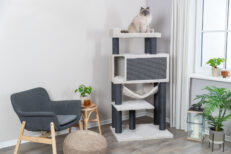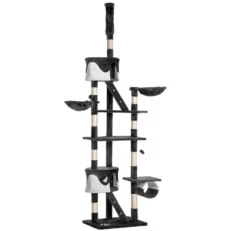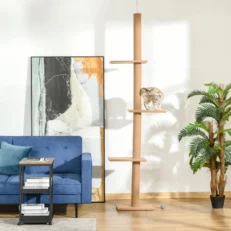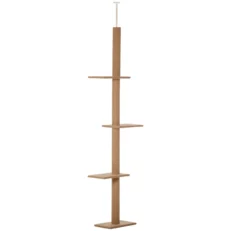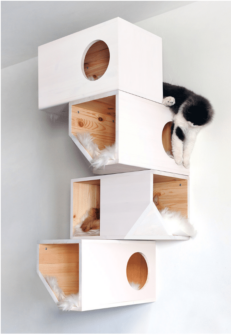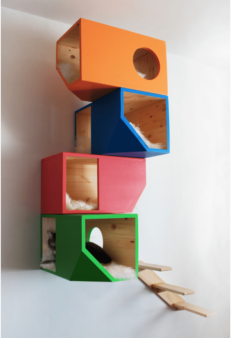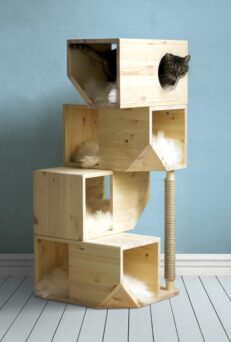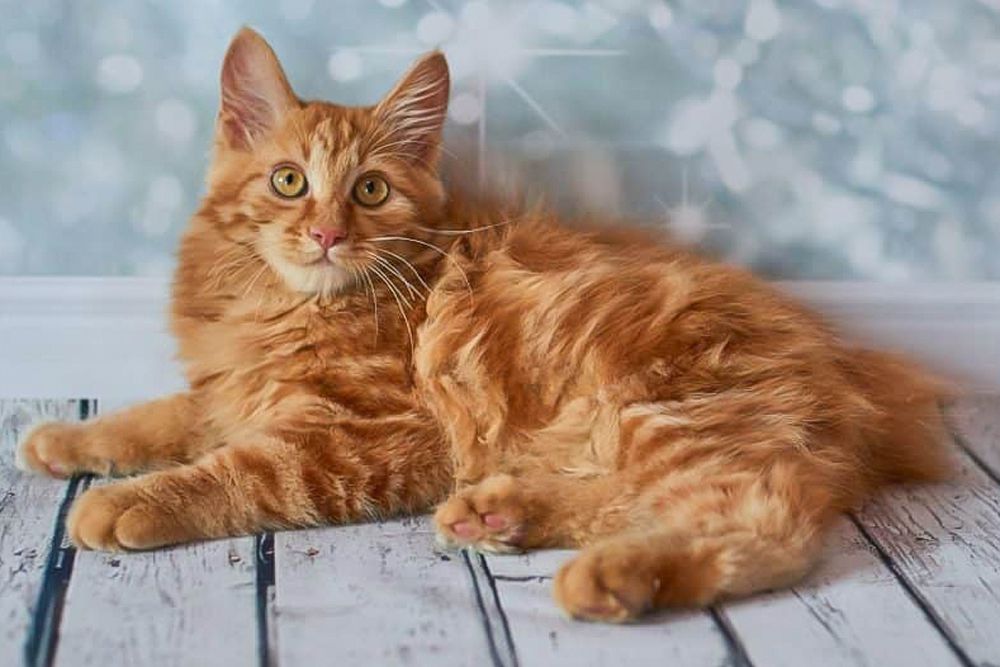
Embracing the Unique Charm of the American Bobtail: Selecting the Perfect Cat Tree.
In the feline world, the American Bobtail stands out as a delightful blend of playfulness and unconventional beauty. With a wild appearance reminiscent of bobtailed wildcats, this breed brings a touch of the untamed to any home it graces. But it’s not just their looks that captivate; their interactive nature and intelligent antics are what truly endear them to their human companions.
In this introduction, we’ll delve into the heart of what makes the American Bobtail so special and why their environment, especially their play structures, is critical to their happiness and health. The American Bobtail’s distinctive physicality, featuring a sturdy body, a surprising bobtail, and a muscular build, demands a cat tree that can withstand and complement their robust play sessions and curious explorations.
Given their reputation for being notably sociable and engaging pets, it’s paramount that their vertical spaces reflect their need for mental stimulation and physical exercise. We’ll discuss how the right cat tree can become a playground, a nap haven, and a lookout spot for these affectionate and adventurous felines.
Join us as we guide you through choosing a cat tree that will not only entertain and challenge your American Bobtail but will also accommodate their unique body shape and dynamic spirit, fostering their overall well-being and nurturing the bond they share with their human families.
Key Traits of the American Bobtail: A Remarkable Blend of Charm and Character
The American Bobtail is a captivating breed known for its distinctive physical traits, endearing personality, and boundless energy. Here, we explore some of the key characteristics that make these cats truly exceptional:
Personality:
Friendly and Affectionate: American Bobtails are renowned for their friendly and affectionate nature. They tend to form strong bonds with their human companions and enjoy being a part of the family.
Intelligent: These cats are highly intelligent and curious. They love exploring their environment and engaging in activities that challenge their minds, making them excellent problem solvers.
Playful: American Bobtails have an innate playfulness that endears them to their owners. They enjoy interactive games, toys, and activities that keep them mentally and physically stimulated.
Physical Traits:
Distinctive Tail: The most striking feature of the American Bobtail is its unique tail. Unlike other breeds, their tails are naturally bobbed or short, giving them a charming appearance. Each tail is one-of-a-kind, varying in length and shape.
Muscular Build: These cats have a strong and muscular build that complements their active lifestyle. Their physique reflects their agility and athleticism.
Medium to Large Size: American Bobtails are medium to large-sized cats with well-proportioned bodies. They have a robust and balanced appearance.
Energy Levels:
High Energy: American Bobtails are known for their high energy levels. They thrive on active play and interaction with their human family members. Providing them with opportunities for physical activity is essential to their well-being.
Need for Climbing: These cats have a natural inclination for climbing. Providing them with cat trees, cat shelves, or elevated spaces can satisfy their desire to explore and perch in high places.
Interactive Play: American Bobtails thrive on interactive play. Toys that mimic prey, such as feather wands or laser pointers, can keep them engaged and mentally stimulated.
In summary, the American Bobtail is a breed that combines the best of both worlds: a loving and affectionate nature with an adventurous and playful spirit. Their unique physical characteristics, high energy levels, and need for interactive play make them a delightful addition to households that appreciate their boundless charm and vitality.
Crafting the Perfect Play Structure for the American Bobtail
American Bobtails, with their notable wild appearance and muscular build, are the epitome of feline agility and strength. These cats are known for their love of “hunting” toys and interactive play, making a well-designed cat tree an essential part of their indoor environment. Here’s what to look for when selecting the ideal cat tree for an American Bobtail:
Durability: The Foundation of Feline Fun
The American Bobtail’s sturdy physique means they need a cat tree that can withstand their robust play sessions. Look for a cat tree with a solid construction that won’t wobble or collapse under the weight and force of an active Bobtail. Heavy-duty materials, such as solid wood or thick particle board, are ideal for longevity and stability. Additionally, a cat tree with high-quality fastenings will ensure it remains secure, no matter how vigorously your Bobtail leaps onto it.
Height and Complexity: Catering to an Adventurous Spirit
An American Bobtail is an intelligent cat that thrives on mental stimulation and physical challenges. A tall cat tree with multiple levels will not only satisfy their climbing instincts but also provide a varied landscape for exploration. Different heights mimic the varying elevations they would encounter in a more natural setting.
Complexity is also key. A variety of platforms, ladders, ropes, and hideaways will keep your American Bobtail intrigued and engaged. This variety encourages them to jump, stretch, and navigate through their miniature jungle gym, catering to their innate problem-solving skills. It’s this level of complexity that will keep your American Bobtail coming back to their cat tree day after day.
In addition, integrating interactive elements such as hanging toys, jingling balls, or puzzles can add an extra layer of stimulation. These additions can tap into their hunting instincts, providing an outlet for their energy and keeping them entertained for hours.
Security for the Tail: A Unique Consideration
Given the American Bobtail’s unique tail, which is typically one-third to one-half the length of an average cat’s tail, it’s essential to ensure that the cat tree has no tight spaces where their tail could get caught or strained. Spacious platforms and passageways will allow them to move freely and comfortably without risking injury to their distinctive appendage.
The ultimate cat tree for an American Bobtail combines durability and complexity to match their physical prowess and mental acuity. By providing a vertical space that challenges and entertains, you’ll not only support their health and well-being but also forge a deeper bond with your playful and loving companion.
Setting up a cat tree for your American Bobtail—a breed known for their playful nature and love for high perches—requires careful attention to both assembly and positioning. Below is a step-by-step guide to ensure your cat tree is assembled safely, along with tips for choosing the best location to encourage climbing and play.
Step-by-Step Guide to Assembling a Cat Tree:
Inventory Parts: Open the box and lay out all the parts and tools. Cross-check with the instruction manual to ensure everything is accounted for. Missing parts should be reported to the manufacturer immediately.
Understand the Design: Familiarize yourself with the design by reviewing the instruction manual. This step will help you visualize the process and identify which parts connect to each other.
Assemble the Base: Start with the base, which is the foundation of stability. Attach the bottom post, making sure it’s tightly screwed in. The base usually has the largest surface area and should be assembled on a flat surface.
Build Upwards: Connect the various platforms and posts as directed, typically working from the bottom up. This method helps to ensure the tree is balanced and helps you catch any mistakes early on.
Secure Each Section: As you add sections, make sure all connections are secure. Tighten any bolts or screws without over-tightening to avoid stripping the material.
Attach Accessories: If the cat tree includes ladders, hammocks, or toys, attach them after the main structure is stable. These should be added according to the manual’s specifications.
Final Inspection: Give the assembled cat tree a thorough inspection. Look for any loose parts, sharp edges, or areas that may splinter. Give it a gentle shake to ensure stability.
Place Mats or Padding: If the cat tree will be on a hard surface, consider placing a non-slip mat underneath to prevent sliding and to protect your floors.
Tips for Choosing the Right Location:
Seek Out Sunlight: American Bobtails, like many cats, enjoy basking in the sun. Place the cat tree in a sunny spot where your cat can enjoy the warmth while lounging on the platforms.
Window Access: Positioning the cat tree near a window can provide your cat with entertainment and stimulation as they watch the outside world. Ensure it’s safe and that windows are securely screened.
Mix Social and Private: Place the cat tree in an area where the family spends time but also offer some privacy. This provides an option for your cat to interact or retreat as desired.
Clear the Area: Make sure the surrounding area is clear of fragile items and potential hazards. Your Bobtail might jump from the tree to other surfaces, so path clearance is essential.
Avoid Isolation: Avoid placing the cat tree in a rarely used room; isolation can deter your cat from using it. Your cat should feel part of the household even when they’re perched up high.
Test and Adjust: After placing the cat tree, observe how your American Bobtail interacts with it. You may need to adjust the location based on their preferences.
With a safely assembled cat tree in the ideal location, your American Bobtail will have a dedicated space for climbing, scratching, playing, and resting, contributing to their physical and mental well-being.
Guiding Your American Bobtail to New Heights: Training Tips for Cat Tree Mastery
American Bobtails are naturals when it comes to agility and play, but even these spirited cats can benefit from guidance when being introduced to new fixtures in their environment, such as a cat tree. To ensure that this new addition becomes a beloved part of their domain, it’s essential to use positive reinforcement and strategic placement to encourage exploration and regular use.
In this segment, we will share effective training techniques designed to appeal to the American Bobtail’s inquisitive and playful nature. By employing a step-by-step approach that rewards each small victory, you can make the cat tree an enticing prospect for your furry friend.
Positive reinforcement remains the cornerstone of effective feline training. We’ll explain how using treats, affection, and playful interaction can turn the cat tree into a source of joy for your Bobtail. By placing their favorite toys on various levels of the tree or engaging in interactive play that incorporates the structure, your cat will begin to associate the tree with fun and rewarding experiences.
Integrating the cat tree into their daily routine is another key strategy. We’ll delve into ways to encourage your cat to scratch, climb, and perch on the tree, activities that cater to their instinctual behaviors. With the right approach, your American Bobtail will soon be scaling their cat tree with the confidence and curiosity that this breed is known for.
Discover the joys of watching your American Bobtail leap and lounge on their cat tree, a testament to the success of patient training and the appeal of a well-chosen play structure. Join us as we unlock the secrets to turning a simple piece of pet furniture into a beloved feature in your cat’s daily life.

